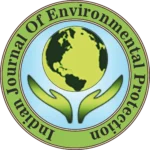IJEP 44(10): 904-911 : Vol. 44 Issue. 10 (October 2024)
Burre Vinay Kumar and T. Usha Madhuri*
Andhra University, Department of Civil Engineering, Visakhapatnam – 530 003, Andhra Pradesh, India
Abstract
River water quality is essential for various purposes, such as drinking, domestic use, irrigation and sustaining aquatic ecosystems. The Sarada river, located in Anakapalli, Andhra Pradesh, plays a crucial role in regional socio-economic development. This study aimed to assess the physical and chemical water quality parameters of the Sarada river in Anakapalli for its suitability for drinking and irrigation. Water samples were collected from four different locations along the river over a six-month period during the dry season. These samples, taken at a depth of one foot below the river’s surface, underwent laboratory analysis to evaluate parameters, including pH, electrical conductivity (EC), total dissolved solids (TDS), total hardness (TH), total alkalinity (TA), calcium (Ca), magnesium (Mg), iron (Fe), nitrate (NO3), sulphates (SO4), chloride (Cl), sodium (Na) and potassium (K). The evaluation methods employed, including water quality index (WQI), nutrient pollution index (NPI), sodium adsorption ratio (SAR) and sodium percentage (Na%), were utilized to assess the river water’s suitability for drinking and irrigation purposes. Specific parameters, such as total hardness, carbonate hardness (CH) and non-carbonate hardness (NCH) were considered in evaluating its appropriateness for drinking. The study’s findings provide insights into the water quality of the Sarada river, offering recommendations and suggesting further research directions to enhance its suitability for drinking and irrigation.
Keywords
Water quality, Sarada river, Anakapalli, Water quality index, Sodium adsorption ration, Sodium percentage, Nemerow’s pollution index
References
- Brown, R.M., et al. 1972. Water quality index- crossing the physical barrier. International Conference on Water pollution research, Jerusalem. Proceedings, 6: 787-797.
- IS 10500. 2012. Indian standard drinking water specification. Bureau of Indian Standards, New Delhi.
- Uddin, M.N., et al. 2014. An assessment of the river water quality parameters: A case of Jamuna river. J. Env. Sci. Natural Resour., 7(1): 249-256.
- Devi, M.K., et al. 2017. Self-purification capacity of Bhavani river. Res. J. Eng. Sci., 6(3): 1-4.
- Rakotondrabe, F., et al. 2017. Assessment of surface water quality of Betare-Oya gold mining area (East-Cameroon). J. Water Resour. Prot., 9: 960-984.
- Batabyal, A. K. and S. Chakraborty. 2015. Hydro-geochemistry and water quality index in the assessment of groundwater quality for drinking uses. J. Water Env. Res., 87(7): 607-617.
- Satyanarayana, P., et al. 2013. Urban groundwater quality assessment: A case study of Greater Visakhapatnam Municipal Corporation area (Gvmc) Andhra Pradesh, India. Int. J. Eng. Sci. Invention. 2: 20-31.
- Xu, G., et al. 2010. Application of Nemerow pollution index in landscape river water quality assessment of river Tianjin, Chengdu, China. 4th International Conference on Bioinformatics and biomedical engineering. DOI: 10.1109/ICBBE.2010.5514 830
- Juned, A.S., et al. 2010. Analysis of chloride, sodium and potassium in groundwater samples of Nanded city in Mahabharata, India. European J. Experimental Biol., 1 (1): 74-82.
- Devadas, D.J., et al. 2017. Hydrogeochemistry of Sarada river basin. J. Env. Earth Sci., 52(7): 1331-1342.
- Central Ground Water Board. 2020. Ground water year book 2019-20: Andhra Pradesh. Ministry of Jal Shakti, Department of Water Resources, River Development & Ganga Rejuvenation, Government of India, Visakhapatnam. pp 1-7.
- Central Water Commission (CWC). 2019. Annual report 2018-2019. Ministry of Water Resources, River Development & Ganga Rejuvenation, Government of India, New Delhi. pp 32-40.
- UNICEF. 2008. Handbook on water quality. United Nations Children’s Fund, New York. pp 19-44.
- Sengupta, S. 2018. Cleaning Indias polluted rivers. DownToEarth.
- CPHEEO manual on water supply and treatment. 2009. Deaprtment of Drinking Water and Sanitation, Ministry of Jal Shakti, Govt. of India. pp 49-52.
- Goel, P.K. 2006. Water pollution: Causes, effects and control (revised 2nd edn). New Age International Publishers, New Delhi, India. pp 3-7, 47, 221-223.
- Robarts, et al. 2008. Water quality monitoring and assessment: Current status and future needs. The 12th World Lake Conference (Taal 2007): Conserving lakes and wetlands for future. Proceedings, pp 167-175.
- Bartram, J. and R. Ballance. 1996. Water quality monitoring: A practical guide to the design and implementation of freshwater quality studies and monitoring programmes. Published on behalf of United Nations Environment Programme and the World Health Organization.
